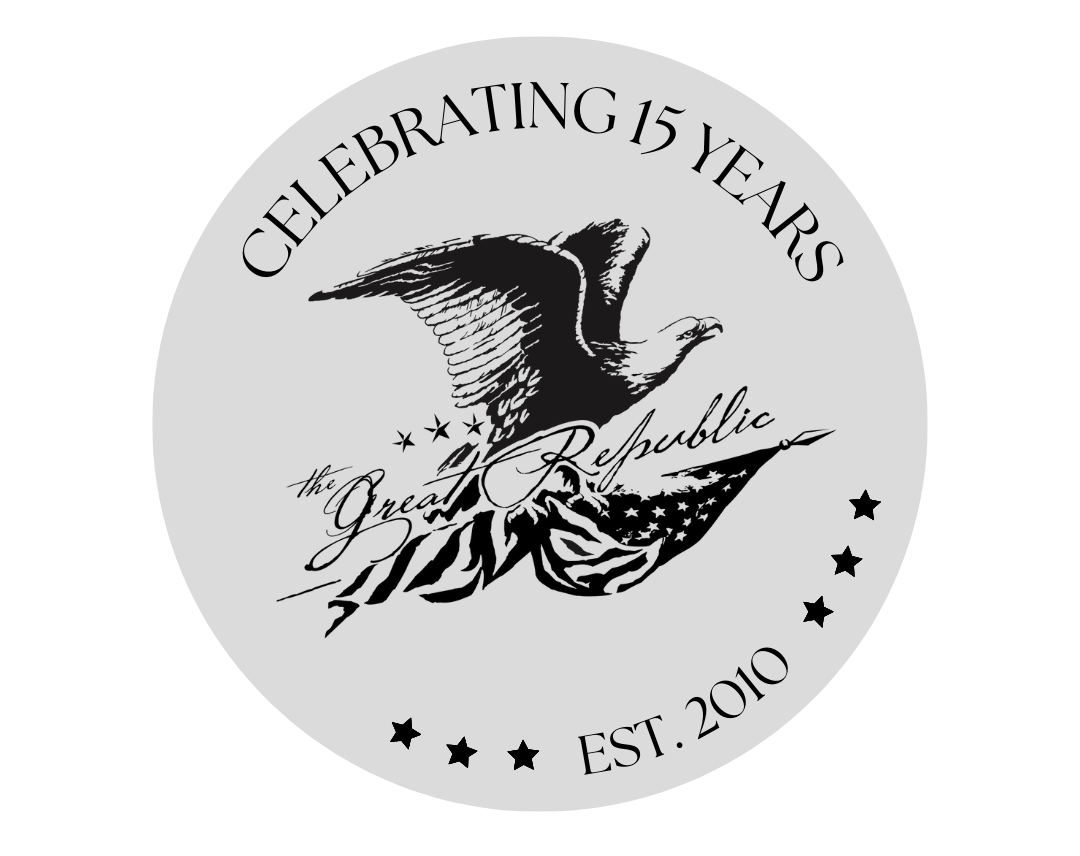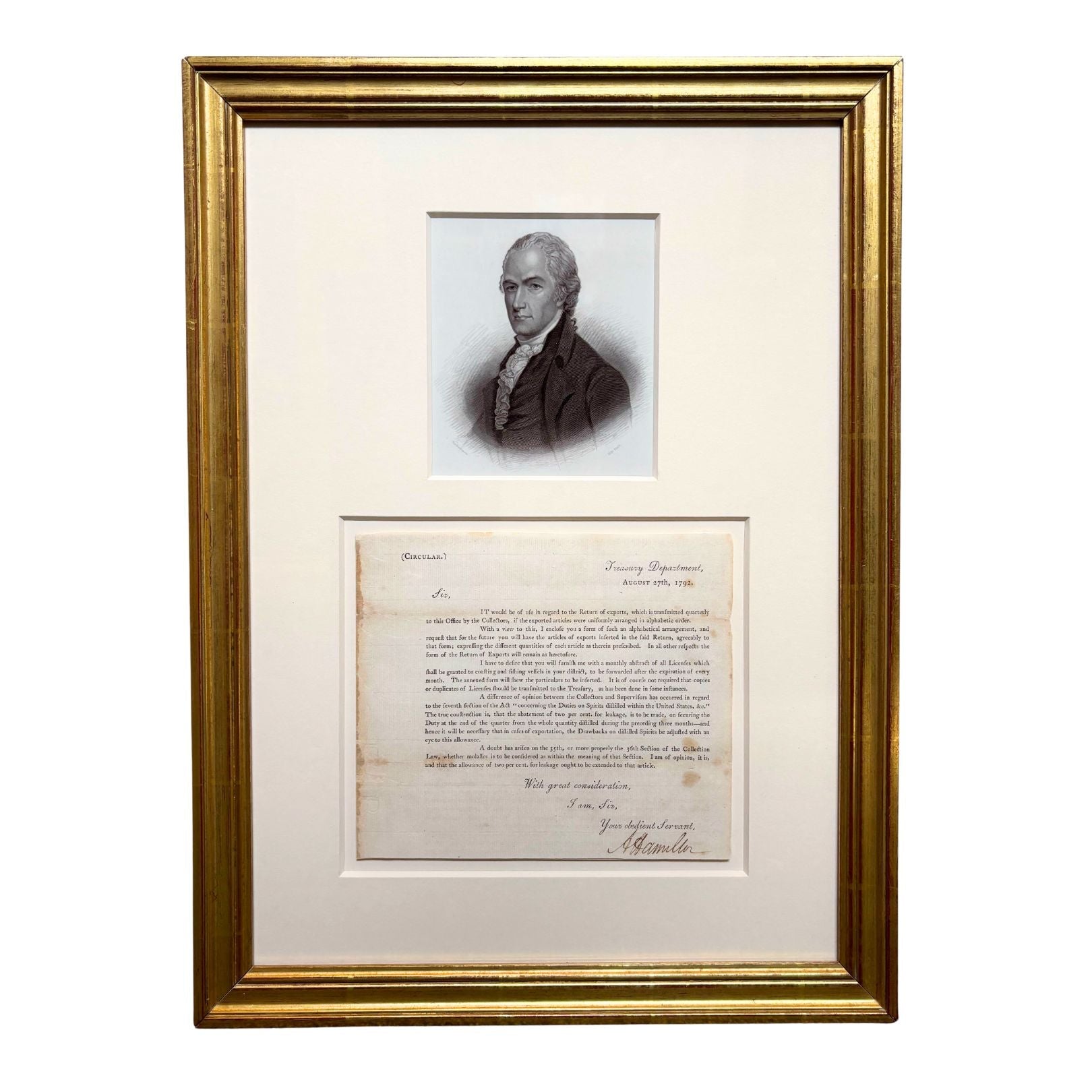
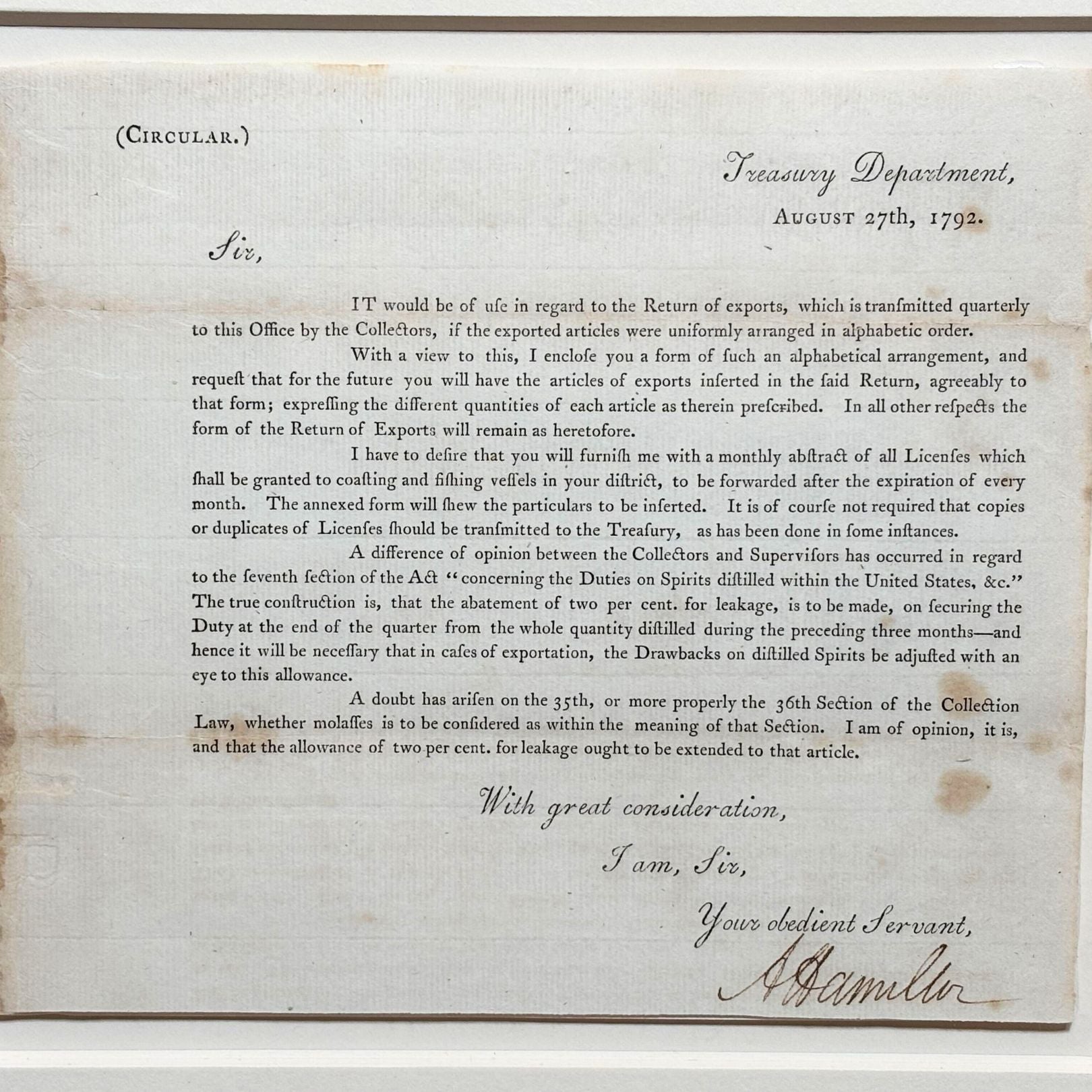
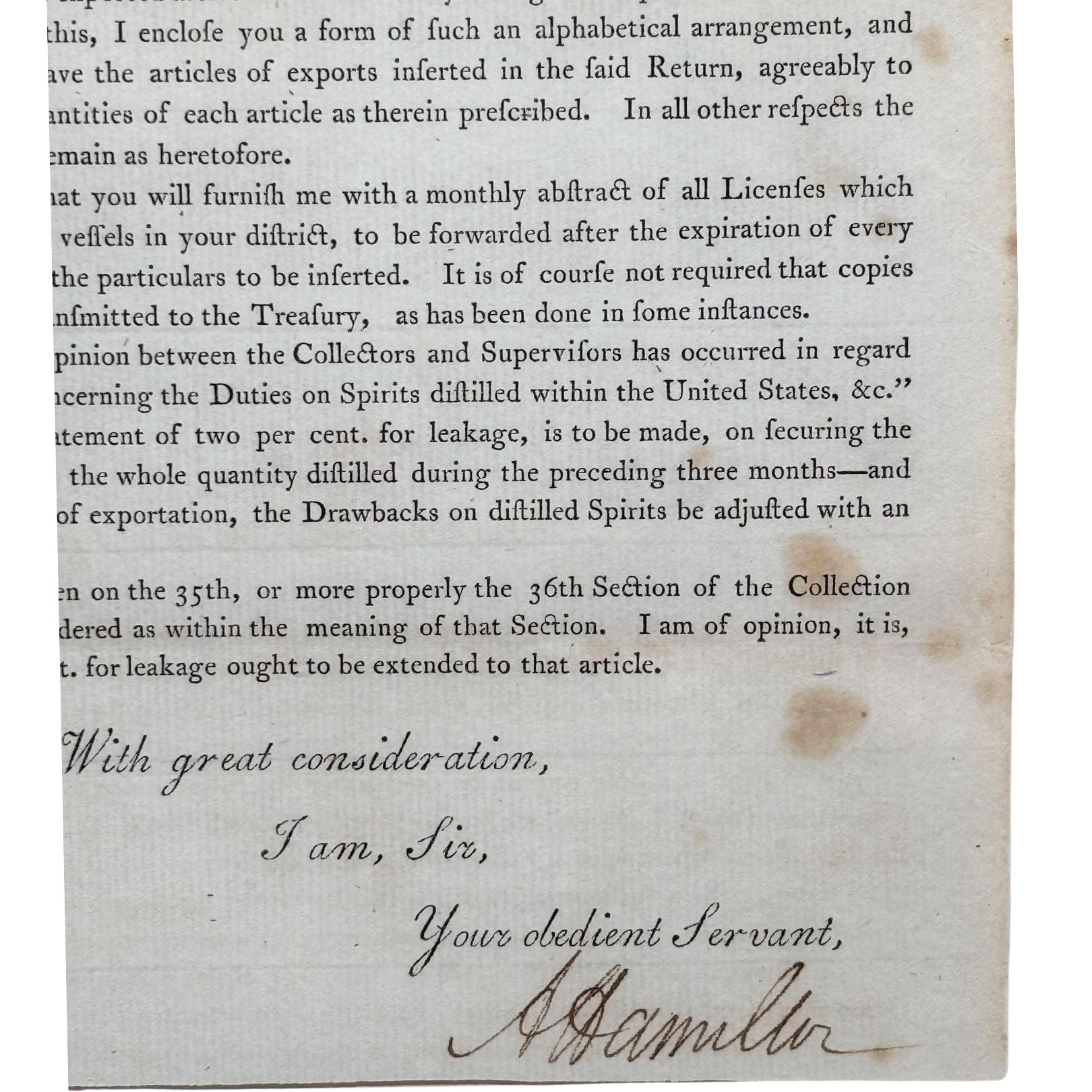
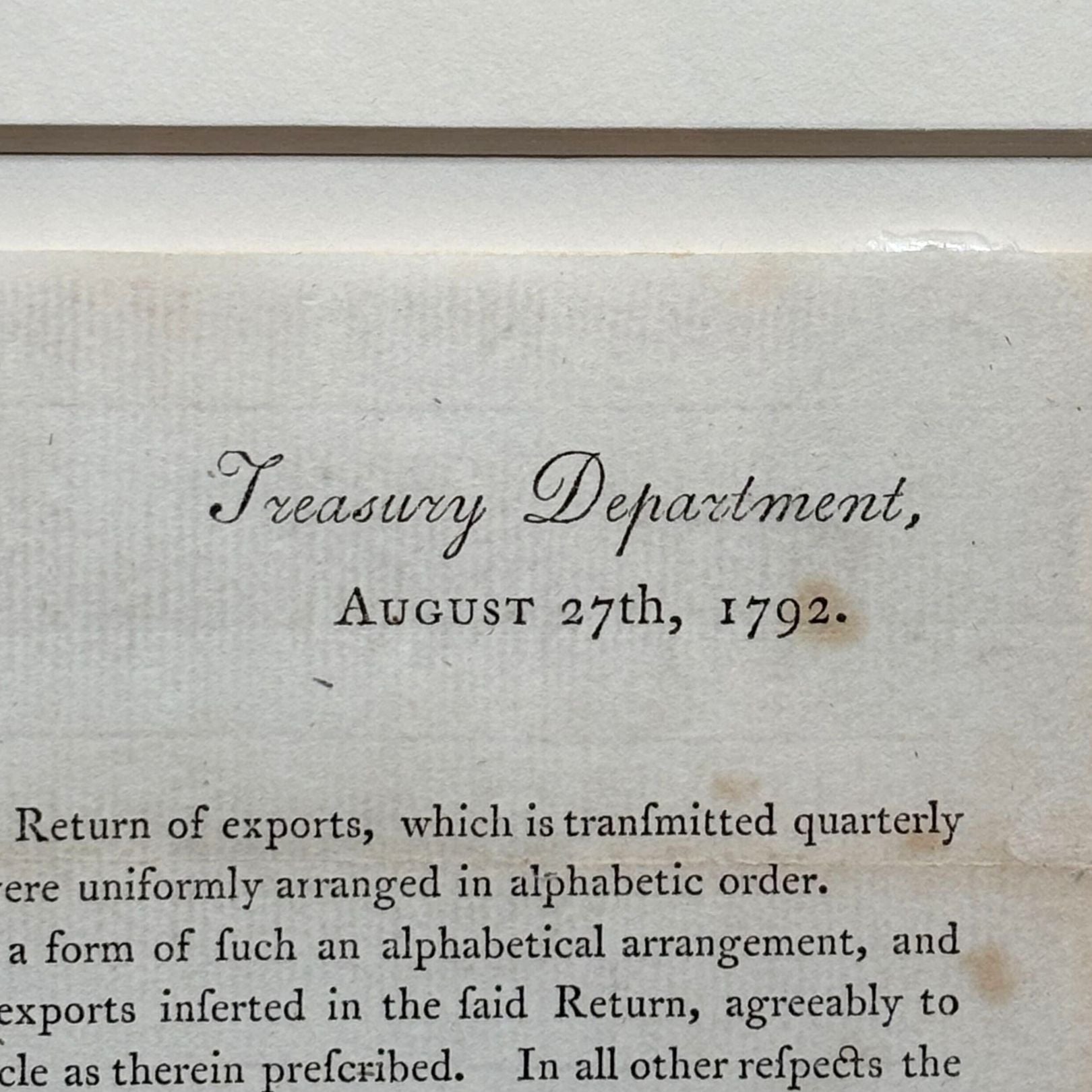
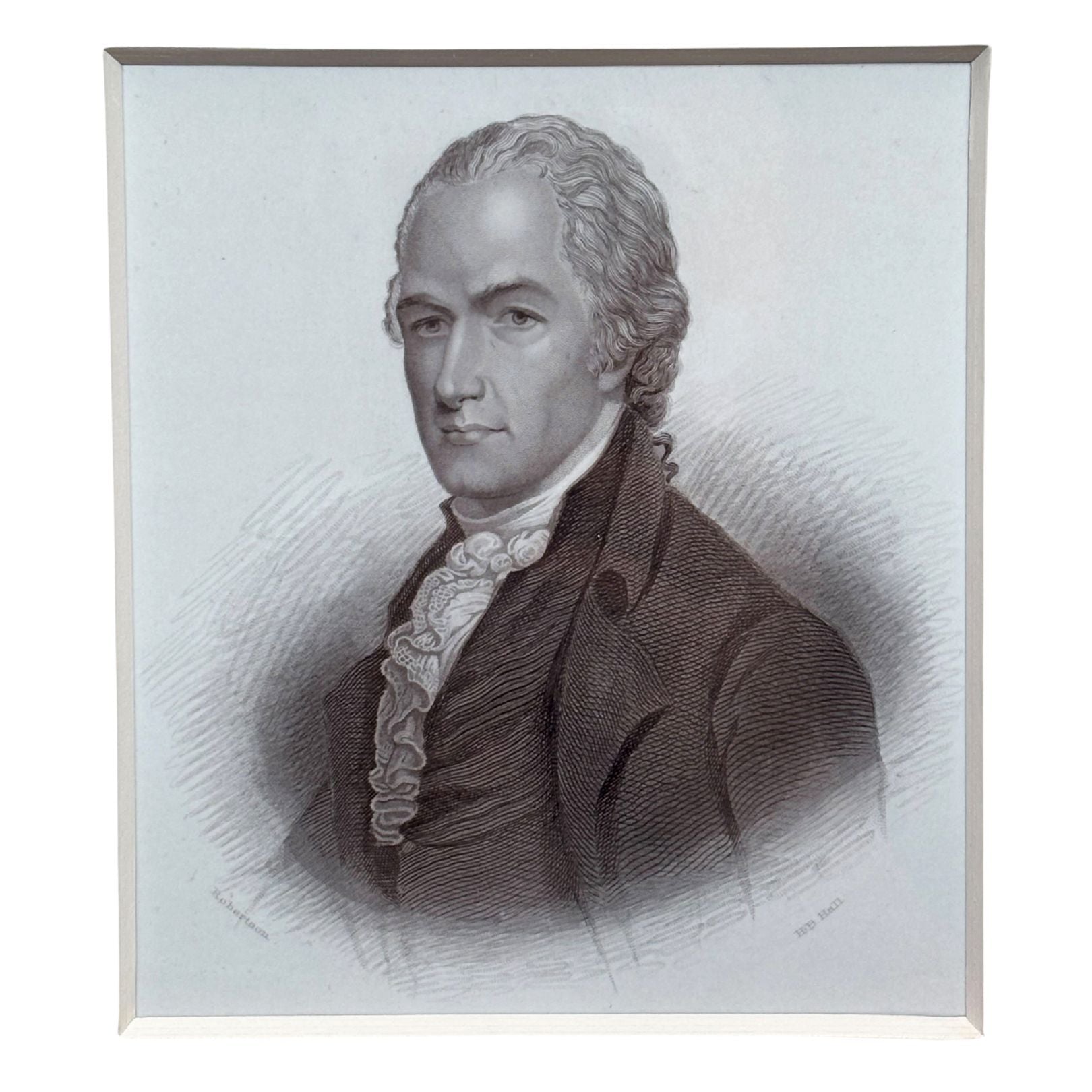
Alexander Hamilton Signed Letter, Dated August 27, 1792
Presented is a highly collectible collage featuring the autograph of Alexander Hamilton. The collage features an original signed Treasury Department circular, dated August 27, 1792, where Hamilton addresses his expectations for reporting on export activity, including fishing and coastal trade. He also gives new procedural clarifications concerning the exportation of goods, particularly distilled spirits and molasses, under federal revenue laws. By addressing both administrative reporting structures and technical taxation concerns, this document underscores Hamilton’s legacy as a key architect of the American financial system. This printed Treasury Department circular includes Hamilton's signature at bottom. The letter is boldly signed "A. Hamilton" in black ink. The circular has been artfully framed with a portrait of Hamilton, engraved by Henry Bryan Hall, after a painting by Archibald Robertson.
The printed Treasury Department circular reads, in full:
“TREASURY DEPARTMENT August 27, 1792,
Sir,
IT would be of use in regard to the Return of exports, which is transmitted quarterly to this Office by the Collectors, if the exported articles were uniformly arranged in alphabetic order.
With a view to this, I enclose you a form of such an alphabetical arrangement, and request that for the future you will have the articles of exports inserted in the said Return, agreeably to that form; expressing the different quantities of each article as therein prescribed. In all other respects the form of the Return of Exports will remain as heretofore.
I have to desire that you will furnish me with a monthly abstract of all Licenses which shall be granted to coasting and fishing vessels in your district, to be forwarded after the expiration of every month. The annexed form will shew the particulars to be inserted. It is of course not required that copies or duplicates of Licenses should be transmitted to the Treasury, as had been done in some instances.
A difference of opinion between Collectors and Supervisors has occurred in regard to the seventh section of the Act “concerning the Duties on Spirits distilled with the United States, &c.” The true construction is, that the abatement of two per cent, for leakage, is to be made, on securing the Duty at the end of the quarter from the whole quantity distilled during the preceding three months—and hence it with be necessary that in cases of exportation, the Drawbacks on distilled Spirits be adjusted with an eye to this allowance.
A doubt has arisen on the 35th, or more properly the 36th Section of the Collection Law, whether molasses is to be considered as within the meaning of that Section. I am of the opinion, it is, and that allowance of two per cent, for leakage ought to be extended to that article.
With great consideration,
I am, Sir,
Your obedient Servant,
A. Hamilton”
In this circular, Hamilton resolves a dispute between Collectors and Supervisors regarding the interpretation of the seventh section of the 1791 Act "concerning the Duties on Spirits distilled within the United States." He confirms that a two percent allowance for leakage should be deducted from the total quantity distilled over a three-month period when securing duties at quarter’s end. He further instructs that export-related drawbacks on distilled spirits must be calculated with this leakage allowance in mind, ensuring distillers are not taxed on product lost during shipping.
Beyond the issue of liquor duties, the circular also outlines Hamilton’s specific, alphabetical, expectations for reporting on export activity, and reporting of new fishing and coastal licenses. He provides instructions for how such activity should be documented and references a standardized reporting form (not included with the document). This reflects his continued efforts to impose structure, uniformity, and accountability across the young republic’s revenue collection apparatus.
Issued just three years after Hamilton’s appointment as the first Secretary of the Treasury, this circular offers viewers a practical example of how Hamilton implemented the taxing authority granted under the new Constitution. His attention to procedural clarity and revenue fairness, such as exempting lost product from taxation, helped stabilize federal income streams while also encouraging compliance among merchants and distillers. By addressing both the technical concerns and administrative structure, this circular illustrates how seemingly minor directives played an important role in shaping the operational capacity of the early Treasury Department, and the broader federal government.
As one of the Founding Fathers of the United States and an author of the Federalist Papers, Alexander Hamilton's legacy lives on even centuries after his death. Hamilton was an American statesman, politician, scholar, military commander, lawyer, banker and economist who held a very important role in the founding of the United States. He acted as the country's very first Secretary of the Treasury and authored countless policies under George Washington's administration. Hamilton was also instrumental in the founding of the first national bank, the country's first tariff system, and established commercial economic policy for the newly formed nation.
CONDITION:
Overall good to very good condition for age. 1 page, typed Secretary of the Treasury letter, signed "A Hamilton" in black ink at bottom. Laid paper. Staining along the left side margin, scattered light staining throughout. Previous repair and archival fill to left side margin.
The Treasury Department circular is artfully framed with a small head and shoulders portrait engraving of Alexander Hamilton, by Henry Bran Hall, after a painting by Archival Robertson. The engraving was published in New York by G. P. Putnam.
The entire collage has been framed according to archival standards in a custom-made gold frame with acid-free matting and backing.
Framed Dimensions: 18 15/16" H x 13 15/16" W x 15/16" D.
Accompanied by our company's letter of authenticity.
Pickup available at Colorado
Usually ready in 4 hours

Alexander Hamilton Signed Letter, Dated August 27, 1792
Colorado
1 Lake Avenue
Colorado Springs CO 80906
United States
Choose options





Frequently Asked Questions
FAQs
Yes, all of our Antiques are certified authentic. Every antique comes with a signed Letter of Authenticity that details the item’s history, its current condition including any conservation, binding, or framing work, and the item’s provenance. The Letters of Authenticity are priced valuations by our authentication specialists, who assure that items are original and unconditionally guaranteed as genuine for life.
We pack and ship your items from our gallery in Colorado Springs. You may also choose to come pick up your order. Antique items are carefully packed and insured during shipping. The shipping price will be calculated at checkout.
We acquire from a variety of trusted sources all over the world, but mostly through auctions and private collections within the United States. All provenance information will be listed on the Letter of
Authenticity accompanying your purchase.

